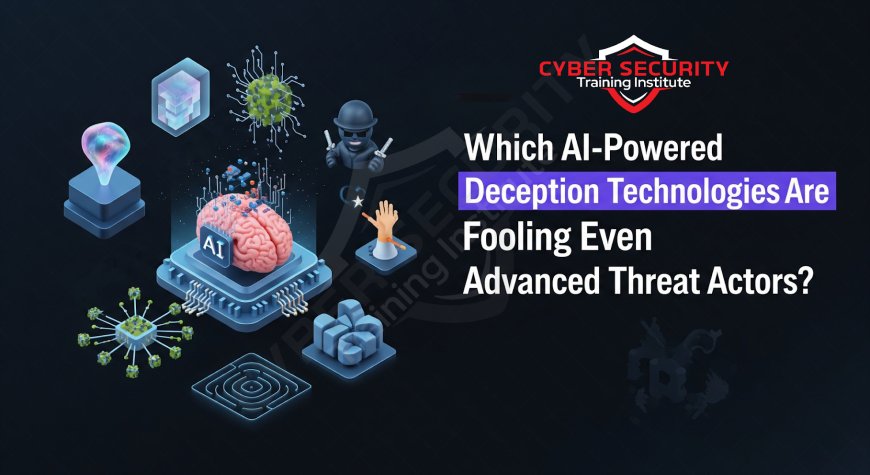Which AI-Powered Deception Technologies Are Fooling Even Advanced Threat Actors?
In 2025, defenders are going on the offensive with AI-powered deception technology. Discover the cutting-edge decoy and honeypot strategies that are being used to fool, detect, and study even advanced threat actors. This analysis, written from Pune, India in July 2025, explores the shift from static honeypots to dynamic, AI-driven "deception fabrics." It details how Generative AI is used to create realistic decoy documents, users, and application environments that lure attackers into controlled traps. The article profiles the leading categories of deception technology, discusses how adversaries are trying to counter them, and explains how these tools provide invaluable, high-fidelity threat intelligence. It serves as a guide for organizations looking to implement a proactive, deception-based defense strategy.

Table of Contents
- Introduction
- From Static Honeypots to Dynamic Deception Fabrics
- Turning the Tables: Why Deception Tech is a Key 2025 Strategy
- How an AI-Powered Deception Platform Works
- Leading AI-Powered Deception Technologies in 2025
- The Attacker's Response: Counter-Deception Techniques
- The Ultimate Payoff: High-Fidelity Threat Intelligence
- Best Practices for Deploying a Deception Strategy
- Conclusion
- FAQ
Introduction
For decades, cybersecurity has been a fundamentally reactive discipline. Defenders build walls, and attackers find ways to breach them. We wait for an alert, then we respond. But what if we could turn the tables? What if, instead of waiting for an attack, we could lure adversaries into a trap of our own making? This is the promise of deception technology, a field that has been supercharged by Generative AI. In 2025, modern deception is not about setting up a simple, lonely honeypot; it's about creating a dynamic, AI-generated "hall of mirrors" that is so realistic it can fool even sophisticated state-sponsored actors. This leads to a fascinating question: Which AI-powered deception technologies are fooling even advanced threat actors?
From Static Honeypots to Dynamic Deception Fabrics
The original deception technology was the honeypot—a single, vulnerable server set up to attract attackers. While useful for research, skilled hackers quickly learned to identify these decoys by their lack of realistic data, traffic, and user activity. The modern approach is the deception fabric. This is not a single device, but an entire layer of deception woven across the real network. It uses AI to automatically create and deploy thousands of interlocking decoys—fake endpoints, servers, applications, and user accounts—that are indistinguishable from real assets. Any interaction with any of these decoys is, by definition, a high-fidelity alert that an attacker is on the network.
Turning the Tables: Why Deception Tech is a Key 2025 Strategy
The adoption of AI-powered deception has surged this year as organizations seek to move from a reactive to a proactive security posture:
- The Failure of Pure Prevention: With AI-driven attacks bypassing traditional defenses, organizations acknowledge that some breaches are inevitable. Deception provides a powerful "detect and respond" capability for when prevention fails.
- High-Fidelity, Low-Noise Alerts: Unlike a SIEM which generates thousands of alerts, a deception platform generates very few. But when an alert fires, it is almost certainly a real threat, as no legitimate user has any reason to be touching a decoy asset.
- Early-Warning Threat Intelligence: Deception allows defenders to detect an attacker during the reconnaissance or lateral movement phase, long before they reach their final objective (like deploying ransomware).
- The Power of Generative AI: GenAI has made it possible to create realistic decoy content—documents, emails, database entries, user profiles—at a scale and quality that was previously impossible, making the deception far more believable.
How an AI-Powered Deception Platform Works
A modern deception platform uses AI to automate the entire process of creating and managing a believable fake environment:
- 1. Network Baselining and Learning: The platform's AI first learns what is "normal" on the real network. It analyzes existing servers, naming conventions, user roles, and application traffic.
- 2. Decoy Generation and Deployment: Based on this learning, the AI automatically generates and deploys decoys that perfectly match the real environment. It can create a fake database server that looks identical to the real finance server, or a decoy workstation with a user profile that matches a real HR employee.
- 3. Lure and Breadcrumb Placement: This is the crucial step. The AI strategically plants "breadcrumbs" or "lures" on real systems to guide attackers towards the decoys. This could be a saved password in a browser pointing to a fake server, a cached credential for a decoy user, or a network share link to a decoy file server.
- 4. Threat Intelligence Capture: Once an attacker interacts with a decoy, the platform switches into a high-fidelity recording mode. It logs every keystroke, command, and network connection the attacker makes, providing invaluable intelligence on their tools, techniques, and ultimate objectives.
Leading AI-Powered Deception Technologies in 2025
The deception market offers a range of sophisticated, AI-enhanced tools designed to trap attackers at different stages of the kill chain:
| Deception Category | Description | How AI Enhances It | Primary Use Case |
|---|---|---|---|
| AI-Generated Decoy Documents | Fake Word docs, PDFs, and spreadsheets with enticing names like `merger_plans.docx` or `employee_salaries.xlsx`. | GenAI creates realistic, context-aware content for these documents, making them believable lures. AI can also embed "canary tokens" that beacon back when the document is opened. | Detecting data exfiltration and lateral movement when an attacker finds and opens a decoy file on a compromised file share. |
| Intelligent Honeypots (High-Interaction) | Fully functional decoy systems (e.g., a fake Windows Domain Controller or a Linux web server) that an attacker can interact with deeply. | AI dynamically generates responses and system behaviors to keep the attacker engaged, making the honeypot seem real and preventing the attacker from getting suspicious. | Studying an attacker's TTPs in a safe, controlled environment. Capturing zero-day exploits and new malware samples. |
| Simulated Application Environments | Decoy versions of critical enterprise applications, such as SAP, Salesforce, or internal banking software. | The AI learns the look and feel of the real application and can generate a believable fake login page and user interface. | Catching attackers specifically targeting high-value business applications, often for financial fraud or industrial espionage. |
| Decoy User & Admin Accounts | Fake user accounts ("honey-users") with plausible-looking credentials stored in places like browser password managers or configuration files. | AI can generate realistic user histories, social media profiles, and email traffic for these accounts to make them appear legitimate upon investigation by an attacker. | Detecting credential theft and privilege escalation attempts. Any login attempt with a decoy credential is an immediate, high-confidence alert. |
The Attacker's Response: Counter-Deception Techniques
This technology has not gone unnoticed by adversaries. The most advanced threat actors are now actively "deception-aware." Before launching an attack, they will perform checks to try and determine if they are in a real or a decoy environment. These checks include:
- Looking for signs of virtualization that are common in honeypot environments.
- Checking for a lack of "human noise": a system with perfectly organized files and no random user errors can be a red flag.
- Analyzing data for authenticity: AI-generated data can sometimes lack the subtle, chaotic inconsistencies of real-world data.
This has sparked an arms race, with deception vendors now using AI to make their decoys even more realistic and "messy" to evade these detection techniques.
The Ultimate Payoff: High-Fidelity Threat Intelligence
While early detection is a key benefit, the true power of AI-powered deception is the unparalleled threat intelligence it provides. When an attacker is inside a high-interaction honeypot, they believe they are in a real system. As a result, they use their best tools and techniques. Defenders get a front-row seat to observe:
- The exact malware and zero-day exploits they are using.
- The specific commands they type to move laterally and escalate privileges.
- The C2 infrastructure they connect back to.
- Their ultimate objective—what data they are searching for.
This intelligence is pure gold. It can be used to immediately harden the real production systems against the exact TTPs being used by an active attacker on the network.
Best Practices for Deploying a Deception Strategy
For organizations in India looking to leverage this technology, a strategic deployment is key:
- Integrate with Your SOC: Deception alerts must be fed directly into your SIEM and SOAR platforms to correlate with other security events and enable automated responses (like isolating the attacker's real endpoint).
- Make Your Decoys Believable: Your decoys should mirror your real, high-value assets. If your most critical server is a Linux database, your primary decoy should be a realistic-looking Linux database server, not a generic Windows machine.
- Start Small, Then Scale: Begin by deploying a few high-value decoys in a critical network segment. Use the learnings from those initial alerts to expand your deception fabric across the enterprise.
- Have a Response Plan: Know exactly what you will do when an alert fires. Will you immediately block the attacker, or will you allow them to continue interacting with the decoy to gather more intelligence? This decision should be made in advance.
Conclusion
In the complex cybersecurity landscape of 2025, waiting for an attack is no longer a viable strategy. AI-powered deception technology has flipped the script, allowing defenders to go on the offense by creating intelligent, dynamic traps. By luring attackers into realistic decoy environments, organizations can generate the highest-fidelity alerts possible, detect threats earlier in the kill chain, and gather invaluable intelligence on their adversaries' tools and intentions. Deception technology has matured from a niche academic concept into a powerful and practical tool for proactive defense, turning an organization's own network into its most powerful sensor.
FAQ
What is deception technology?
Deception technology is a category of cybersecurity defense that uses decoy assets—such as honeypots, fake user accounts, and decoy data—to lure, detect, and study attackers in a controlled environment.
What is the difference between a honeypot and a deception fabric?
A honeypot is typically a single, isolated decoy server. A deception fabric is a network-wide, interconnected layer of many different types of decoys (endpoints, servers, users, data) that are designed to look like a real, active enterprise environment.
How does AI make deception more effective?
AI is used to automatically learn what real assets look like and then generate thousands of believable decoys that match the real environment. It also makes the decoys more interactive and realistic, fooling even skilled attackers.
Is any alert from a deception platform a real attack?
Yes, in almost all cases. Since legitimate users have no reason to ever access a decoy asset, any interaction (like a login attempt or a file access) is a high-confidence indicator that a malicious actor is on the network.
What is a "honey-token" or "canary token"?
These are types of digital lures. A canary token could be a fake AWS API key placed in a document. The moment an attacker uses that key, it sends a silent alert back to the defenders, revealing that the document and the attacker's machine have been compromised.
What is a "high-interaction" honeypot?
This is a fully functional decoy system that allows an attacker to interact with it deeply, as if it were a real machine. This provides more valuable intelligence than a "low-interaction" honeypot, which might only emulate a few basic services.
Can't skilled hackers identify these decoys?
While it was easier to spot old, static honeypots, modern AI-driven deception platforms create far more realistic environments. It has become an arms race, with defenders using AI to make decoys more believable and attackers using their own tools to try and detect them.
What is the main goal of using deception technology?
There are two main goals: 1) Early detection of threats that have bypassed other security controls. 2) Gathering high-fidelity threat intelligence about an attacker's tools, techniques, and procedures (TTPs).
Is using deception technology ethical?
Yes. Within the context of defending one's own network, it is widely considered an ethical and legitimate defensive strategy. It does not involve "hacking back" or attacking anyone; it is a passive defense that involves laying traps within your own environment.
How does deception tech integrate with a SOAR platform?
An alert from the deception platform can trigger an automated playbook in a SOAR (Security Orchestration, Automation, and Response) tool. For example, the alert could automatically isolate the attacker's source endpoint from the network to contain the threat.
What are some leading vendors in the deception technology space?
The market includes several well-known vendors such as Attivo Networks (now part of SentinelOne), TrapX, Illusive, and Acalvio, each offering different approaches to creating deception environments.
Can deception be used in the cloud?
Yes, absolutely. Modern deception platforms are designed to deploy decoy cloud resources, such as fake S3 buckets, decoy virtual machines, and fake cloud user accounts, to detect threats in cloud environments like AWS and Azure.
What is a "breadcrumb" in this context?
A breadcrumb is a lure or piece of information intentionally left on a real system to guide an attacker toward a decoy. Examples include a saved password for a decoy server in a browser, or a fake database connection string in a configuration file.
How does deception help against insider threats?
It can be very effective. A curious or malicious insider snooping around the network might stumble upon a decoy file server named "Finance-Backup-AdminOnly" and try to access it. This action would immediately trigger an alert, revealing the insider's activity.
Is this technology expensive?
Commercial deception platforms have traditionally been seen as an advanced, and therefore expensive, capability. However, as the technology matures, it is becoming more accessible to mainstream enterprises as part of broader security platforms.
Can I build my own open-source honeypot?
Yes, there are many open-source honeypot projects available. However, building and managing a full-scale, believable deception fabric that can fool a skilled adversary requires significant time and expertise, which is why many organizations opt for commercial platforms.
What happens after an attacker is detected in a decoy?
The organization's security team has a choice. They can immediately block and eject the attacker, or they can choose to allow the attacker to continue operating within the safe, controlled decoy environment to gather more intelligence about their capabilities.
Does deception technology generate a lot of data?
It generates very little "alert" data, as interactions are rare. However, when an attacker is engaged with a high-interaction honeypot, it can generate a massive amount of valuable forensic data (logs, packet captures, malware samples).
How does deception complement a Zero Trust architecture?
They work very well together. Zero Trust aims to prevent attackers from moving laterally. Deception provides a powerful detection layer to catch an attacker the moment they even *attempt* to move laterally and touch a resource they shouldn't.
Is deception a replacement for other security tools like EDR or firewalls?
No, it is a complementary layer. It is part of a defense-in-depth strategy. Firewalls, EDR, and deception technology all work together, with deception providing a crucial detection capability for when other preventative tools fail.
What's Your Reaction?
 Like
0
Like
0
 Dislike
0
Dislike
0
 Love
0
Love
0
 Funny
0
Funny
0
 Angry
0
Angry
0
 Sad
0
Sad
0
 Wow
0
Wow
0















